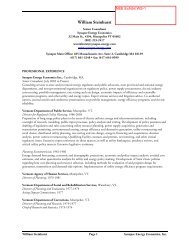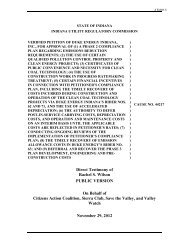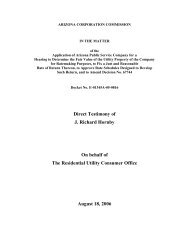Best Practices in Energy Efficiency Program Screening - Synapse ...
Best Practices in Energy Efficiency Program Screening - Synapse ...
Best Practices in Energy Efficiency Program Screening - Synapse ...
Create successful ePaper yourself
Turn your PDF publications into a flip-book with our unique Google optimized e-Paper software.
3.7 L<strong>in</strong>e Losses<br />
Generat<strong>in</strong>g facilities are often located at great distances from customers and require<br />
step-up transformers to get the power onto the transmission system, long transmission<br />
l<strong>in</strong>es, transmission substations, step-down transformers to distribution voltages,<br />
distribution l<strong>in</strong>es, and distribution l<strong>in</strong>e transformers. Losses occur at each of these steps<br />
of the transmission and distribution system. Typical utility-wide average annual losses<br />
from generat<strong>in</strong>g plants to meters ranges from 6 percent to 11 percent, depend<strong>in</strong>g on the<br />
transmission distances, system density, distribution voltages, and the characteristics of<br />
the transmission and distribution system components (RAP 2011b, p.3).<br />
<strong>Energy</strong> efficiency reduces loads at the customer premises, which removes the utility’s<br />
requirement to supply these avoided demands with generat<strong>in</strong>g facilities, thereby<br />
reduc<strong>in</strong>g l<strong>in</strong>e losses. When regulators and utilities value efficiency <strong>in</strong>vestments <strong>in</strong> costeffectiveness<br />
analyses, they often credit energy efficiency with avoid<strong>in</strong>g the average<br />
losses, usually because they are a measured and published figure (RAP 2011b, pp. 1-<br />
3).<br />
However, losses on utility transmission and distribution systems are not uniform<br />
throughout the day or the year. Additionally, efficiency measures generally contribute<br />
more to the reduction of peak demands than they do on average. Consequently, us<strong>in</strong>g<br />
average l<strong>in</strong>e losses understates the l<strong>in</strong>e losses avoided by energy efficiency (RAP<br />
2011b, pp. 1 – 3).<br />
Marg<strong>in</strong>al l<strong>in</strong>e losses are the losses actually avoided when energy efficiency measures<br />
are <strong>in</strong>stalled, and are usually significantly larger than average l<strong>in</strong>e losses. Depend<strong>in</strong>g on<br />
the load shape of the utility, the percentage of generation that is lost before it reaches<br />
loads are typically at least twice as high as the average annual losses on the system.<br />
Further, l<strong>in</strong>e losses <strong>in</strong>crease significantly dur<strong>in</strong>g periods of peak demand on the<br />
electricity system; the time when energy efficiency measures typically provide significant<br />
levels of sav<strong>in</strong>gs. Dur<strong>in</strong>g the highest critical peak hours (perhaps 5 to 25 hours per year)<br />
when the system is under stress, the losses may be four to six times as high as the<br />
average (RAP 2011b, pp. 1 – 4).<br />
Marg<strong>in</strong>al l<strong>in</strong>e losses require more <strong>in</strong>formation and more detailed calculations to measure<br />
than average losses, and few utilities or regulators have studied the marg<strong>in</strong>al losses that<br />
can be avoided with <strong>in</strong>cremental <strong>in</strong>vestments <strong>in</strong> efficiency measures that provide sav<strong>in</strong>gs<br />
at the time of extreme peak demands. However, very significant benefits can result from<br />
measures that reduce peak demand, <strong>in</strong>clud<strong>in</strong>g energy efficiency, demand response, and<br />
use of emergency generators located at customer premises (RAP 2011b, pp. 1-5).<br />
The bottom l<strong>in</strong>e is that energy efficiency measures typically provide significant sav<strong>in</strong>gs at<br />
the time of the system peak demand, and that time occurs when the l<strong>in</strong>e losses are<br />
highest. Therefore, program adm<strong>in</strong>istrators should use marg<strong>in</strong>al l<strong>in</strong>e losses <strong>in</strong> efficiency<br />
cost-effectiveness screen<strong>in</strong>gs <strong>in</strong>stead of average l<strong>in</strong>e losses. As a rule of thumb, utilities<br />
and regulators can assume that marg<strong>in</strong>al losses are about 1.5 times average losses<br />
(RAP 2011b, p.5).<br />
3.8 Illustrative Example<br />
Figure 3.1 below provides an example of the cumulative effect of avoided costs, by<br />
present<strong>in</strong>g the costs broken out by type. These costs are levelized over 20 year for<br />
| 30 <strong>Best</strong> <strong>Practices</strong> <strong>in</strong> <strong>Energy</strong> <strong>Efficiency</strong> <strong>Program</strong> Screen<strong>in</strong>g | www.nhpci.org







